 The Seagate NAS HDD is a 3.5" form factor, 6Gb/s SATA interface hard drive that spins at 5,900RPM, ranges up to 4TB in capacity and is specifically engineered to be installed in one to five-bay NAS devices. With the consumer and small office NAS market growing quickly and with buyers usually opting for diskless models, Seagate is responding to market demand with this specific use-case drive. Of course there are loads of drives out there that users could implement to populate a NAS, but most are overkill or otherwise sub-optimal for the need. Seagate joins the NAS HDD market by designing a drive to handle NAS workload and operational requirements with their NASWorks specialized firmware, three-year warranty and support from many leading NAS vendors.
The Seagate NAS HDD is a 3.5" form factor, 6Gb/s SATA interface hard drive that spins at 5,900RPM, ranges up to 4TB in capacity and is specifically engineered to be installed in one to five-bay NAS devices. With the consumer and small office NAS market growing quickly and with buyers usually opting for diskless models, Seagate is responding to market demand with this specific use-case drive. Of course there are loads of drives out there that users could implement to populate a NAS, but most are overkill or otherwise sub-optimal for the need. Seagate joins the NAS HDD market by designing a drive to handle NAS workload and operational requirements with their NASWorks specialized firmware, three-year warranty and support from many leading NAS vendors.
The Seagate NAS HDD is a 3.5" form factor, 6Gb/s SATA interface hard drive that spins at 5,900RPM, ranges up to 4TB in capacity and is specifically engineered to be installed in one to five-bay NAS devices. With the consumer and small office NAS market growing quickly and with buyers usually opting for diskless models, Seagate is responding to market demand with this specific use-case drive. Of course there are loads of drives out there that users could implement to populate a NAS, but most are overkill or otherwise sub-optimal for the need. Seagate joins the NAS HDD market by designing a drive to handle NAS workload and operational requirements with their NASWorks specialized firmware, three-year warranty and support from many leading NAS vendors.
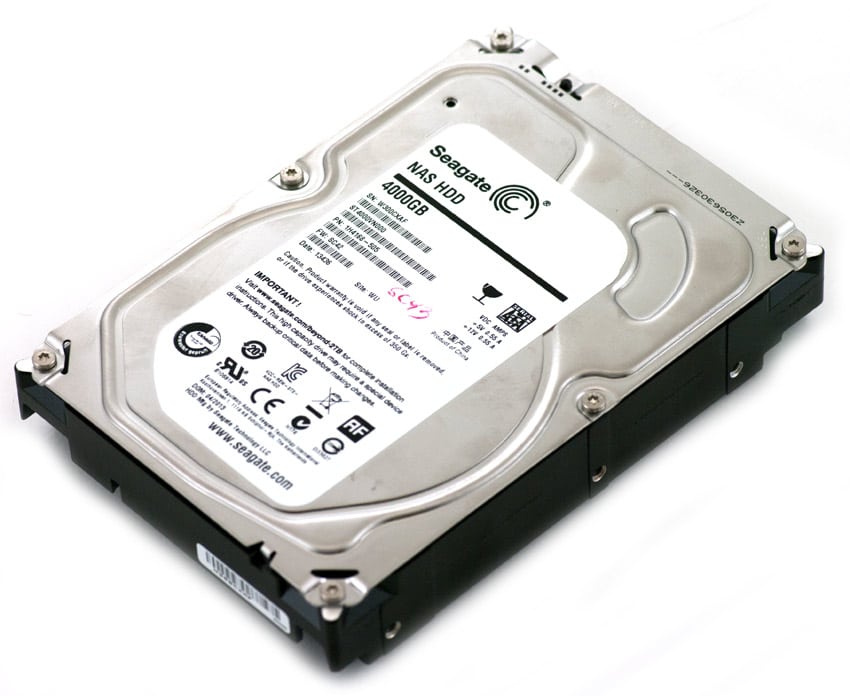
Seagate wants users to feel completely comfortable buying their NAS and then filling it with their NAS HDDs. To that point, Seagate completed compatibility testing with the top NAS providers to qualify the drive with the market's leading systems. Seagate NAS HDDs have been tested with Drobo, Synology, LaCie, LenovoEMC and many other solutions. Seagate also implemented its NASWorks firmware to handle NAS-specific issues that standard desktop HDDs aren't designed to cover. NAS drives need to stand up to demands for NAS error recovery controls, power management features and vibration/shock issues. NASWorks tunes the drive to operate with performance and reliability. Its extended error recovery controls ensure compliance with NAS system requirements to achieve greater data integrity, while its advanced power profiles are designed to provide low power options for the 24/7 always-on operation NAS drives endure. The drive also features a dual-plane balance to support the weighted motor design, thus reducing vibrations for greater performance and reliability.
The Seagate NAS HDD isn't the first drive to market designed specifically for NAS devices; the WD Red NAS Hard Drive that we reviewed last year is already available. However, the Seagate NAS HDD has one major advantage from the outset – it is being offered in 2TB, 3TB and 4TB capacities, while the Red started at 1TB and ranged up to 3TB. That means at the time of this review that the Seagate NAS HDD offers a greater than 30% capacity advantage over the WD Red NAS hard drive. Seagate also quotes drive performance at 10% more than the competition, which we'll test below. One more significant feature in the NAS market is that the NAS HDD operates at just 1.9 bels (2TB). That's below the level of human hearing.
The Seagate NAS HDD comes in 2TB, 3TB and 4TB capacities with a three year warranty. Street pricing is $125.99, $167.99 and $209.99 respectively.
Seagate NAS HDD Specifications
- Capacities
- 2TB (ST2000VN000)
- 3TB (ST3000VN000)
- 4TB (ST4000VN000)
- Performance
- Interface: SATA 6 Gb/s
- Power-On or Standby to Ready (typical, sec): <17
- Maximum sustained transfer rate :180MB/s (4TB/3TB), 159MB/s (2TB)
- Cache: 64MB
- Reliability/Data Integrity
- Non-recoverable read errors per bit read: <10 in 1014
- MTBF: 1,000,000 hours
- Power-On Hours: 8760
- Load/Unload: 600,000
- Voltage
- Voltage Tolerance, Including Noise (5V): ±5%
- Voltage Tolerance, Including Noise (12V): ±10%
- Power Management
- Startup Current (12V, A max): 2.0
- Operating Average (W): 4.8 (4TB/3TB), 4.3 (2TB)
- Idle Average (W): 3.95(4TB/3TB), (2TB) 3.0
- Standby/Sleep Mode (typical, W): 0.5 (4TB/3TB), 0.3 (2TB)
- Environmental
- Operating temperature: 0° to 70°C
- Non-operating temperature: -40° to 70°C
- Temperature Gradient, Operating/Nonoperating (°C per hour max): 20/30
- Operating Shock (2ms, max, Gs): 80
- Non-Operating Shock (2ms, max, Gs): 300
- Acoustics: 4TB/3TB: Idle (typical, bels): 2.3 Operational (typical bels) 2.5; 2TB: Idle (typical, bels): 1.9 Operational (typical bels) 2.1
- Dimensions (HxDxW): 1.028" (26.11mm) x 5.787" (146.99mm) x 4.00" (101.6mm)
- Weight: 4TB/3TB: 1.345lbs (610g); 2TB: 1.18lbs (535g)
Design and Build
The Seagate NAS HDD features the simple standard hard drive design of a silver top cover and black metal body. That top cover features the product information label that provides information about the drive (model, capacity, etc.). The sides of the Seagate NAS HDD feature the six screw holes that enable users to mount the drive, though there are some NAS units that feature tool-less installation in the bays. On the rear of the drive, there are power and SATA connectors.
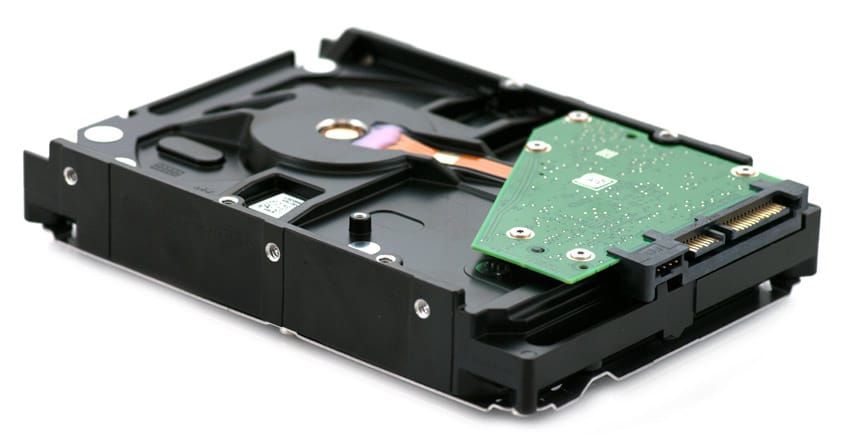
Removing five small screws enables the circuit board to be removed from the body of the Seagate NAS HDD. The circuit board features an LSI 841281VC controller chip and 64MB of cache from the Samsung K4T51163QJ-BCE7 DRAM. Internally, there are four platters at 1TB each on the 4TB models.
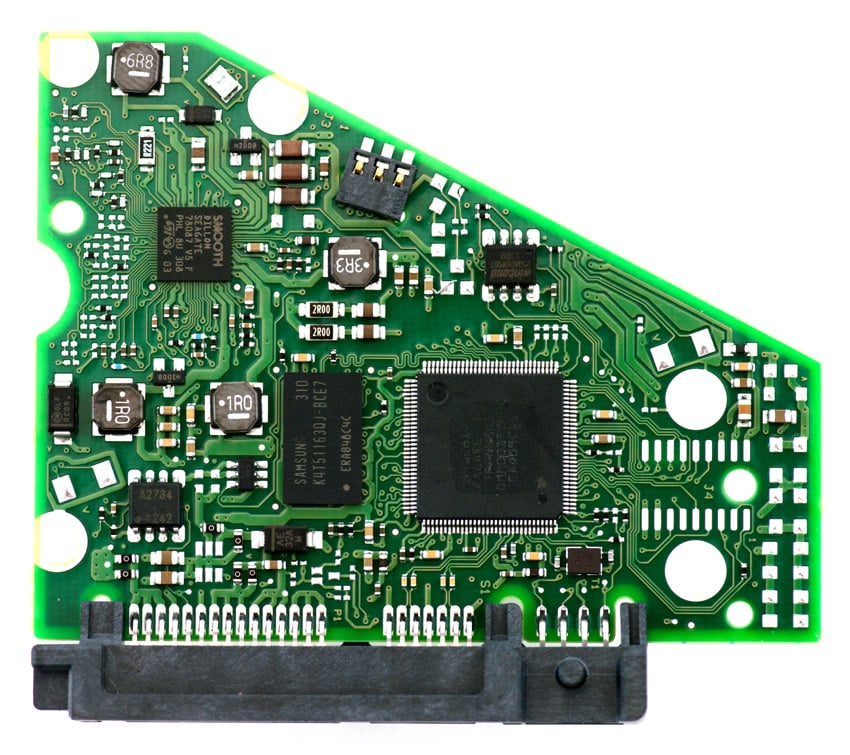
Testing Background and Comparables
Comparables for this review:
- Seagate Constellation CS – Enterprise Value HDD (3TB, 7,200 RPM)
- WD Se (4TB, 7,200RPM)
- WD Red NAS (3TB, 5K-Class RPM)
All enterprise HDDs are benchmarked on our enterprise testing platform based on a Lenovo ThinkServer RD240. The ThinkServer RD240 is configured with:
- 2 x Intel Xeon X5650 (2.66GHz, 12MB Cache)
- Windows Server 2008 Standard Edition R2 SP1 64-Bit and CentOS 6.2 64-Bit
- Intel 5500+ ICH10R Chipset
- Memory – 8GB (2 x 4GB) 1333Mhz DDR3 Registered RDIMMs
- LSI 9211 SAS/SATA 6.0Gb/s HBA
Enterprise Synthetic Workload Analysis
Our enterprise hard drive benchmark process preconditions each drive into steady-state with the same workload the device will be tested with under a heavy load of 16 threads with an outstanding queue of 16 per thread, and then tested in set intervals in multiple thread/queue depth profiles to show performance under light and heavy usage. Since hard drives reach their rated performance level very quickly, we only graph out the main sections of each test.
Preconditioning and Primary Steady-State Tests:
- Throughput (Read+Write IOPS Aggregate)
- Average Latency (Read+Write Latency Averaged Together)
- Max Latency (Peak Read or Write Latency)
- Latency Standard Deviation (Read+Write Standard Deviation Averaged Together)
Our Enterprise Synthetic Workload Analysis includes four profiles based on real-world tasks. These profiles have been developed to make it easier to compare to our past benchmarks as well as widely-published values such as max 4k read and write speed and 8k 70/30, which is commonly used for enterprise drives. We also included two legacy mixed workloads, the traditional File Server and Webserver, each offering a wide mix of transfer sizes.
- 4k
- 100% Read or 100% Write
- 100% 4k
- 8k 70/30
- 70% Read, 30% Write
- 100% 8k
- 128k (Sequential)
- 100% Read or 100% Write
- 100% 128k
- File Server
- 80% Read, 20% Write
- 10% 512b, 5% 1k, 5% 2k, 60% 4k, 2% 8k, 4% 16k, 4% 32k, 10% 64k
- Webserver
- 100% Read
- 22% 512b, 15% 1k, 8% 2k, 23% 4k, 15% 8k, 2% 16k, 6% 32k, 7% 64k, 1% 128k, 1% 512k
In the first of our enterprise workloads, we measured a long sample of random 4k performance with 100% write and 100% read activity to get our main results. The Seagate NAS HDD 4TB measured 89 IOPS read and 116 IOPS write, which was just slightly greater than the WD Red 3TB.
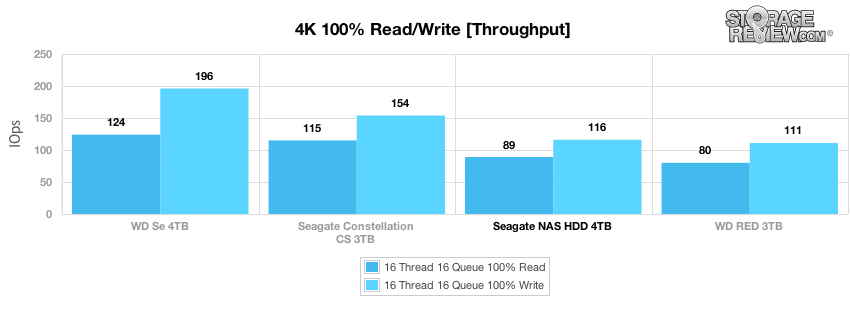
In our main average latency segment with a load of 16T/16Q, we measured an average read latency of 2836.32ms and a write latency of 2183.41ms from the Seagate NAS HDD, which again beat out just the WD Red 3TB.
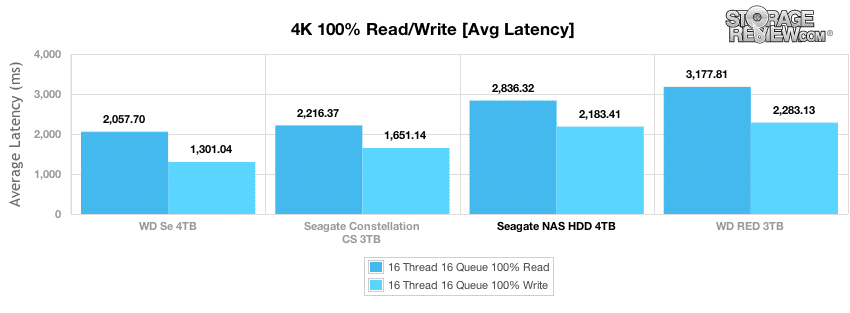
Measuring just read activity, the Seagate NAS HDD had a max response time of 5855.0ms while the write activity max latency was 5847.0ms. The read activity max beat out the WD Red and the Seagate Constellation CS, while the write activity response time was at the back of the group.
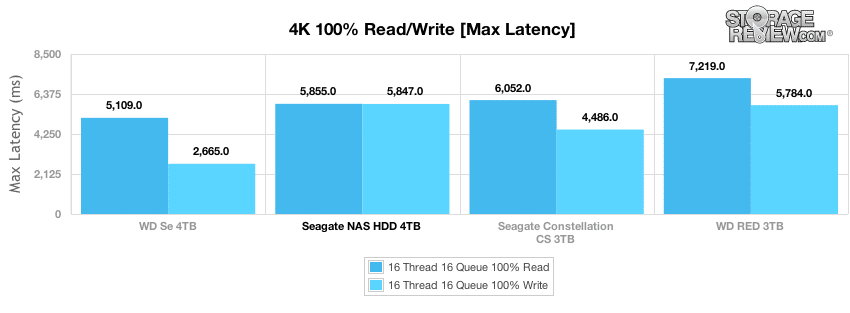
Reviewing the 4k latency consistency in our standard deviation section, the Seagate NAS HDD tested third out of the four drives at 703.64ms for read standard deviation. It came in with the weakest figure at 718.45ms for write standard deviation.
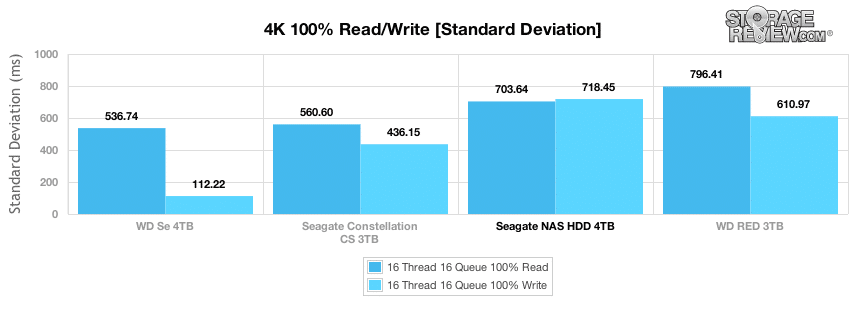
Compared to the fixed 16 thread, 16 queue max workload we performed in the 100% 4k write test, our mixed workload profiles scale the performance across a wide range of thread/queue combinations. In these tests, we span workload intensity from 2 threads and 2 queue up to 16 threads and 16 queue. In the expanded 8k 70/30 test, the Seagate NAS HDD came in third place above the WD Red, ranging from 83 IOPS in the 2T2Q segment to 103-109 IOPS at the terminal queue depths.
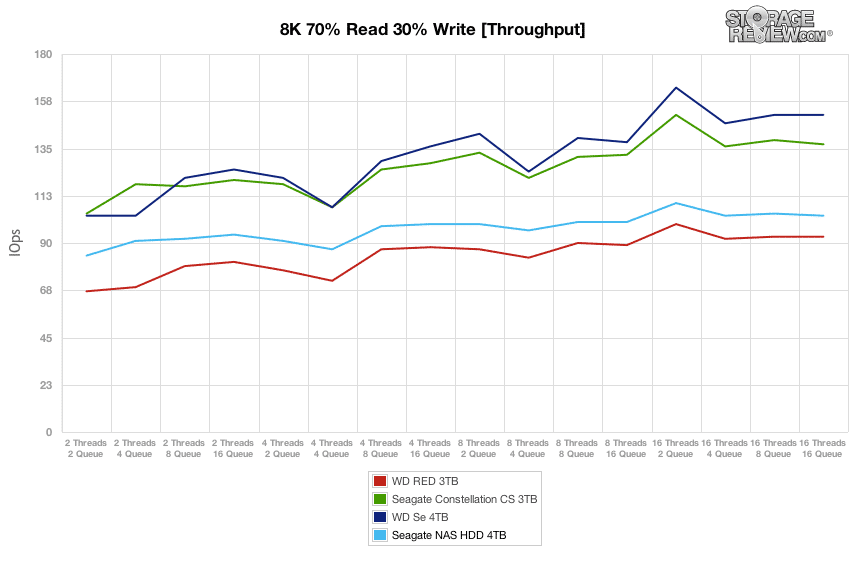
Looking over the 8k 70/30 average response times, the Seagate NAS HDD stayed within range of the WD Se and the Seagate Constellation CS, but it finished second from the bottom again.
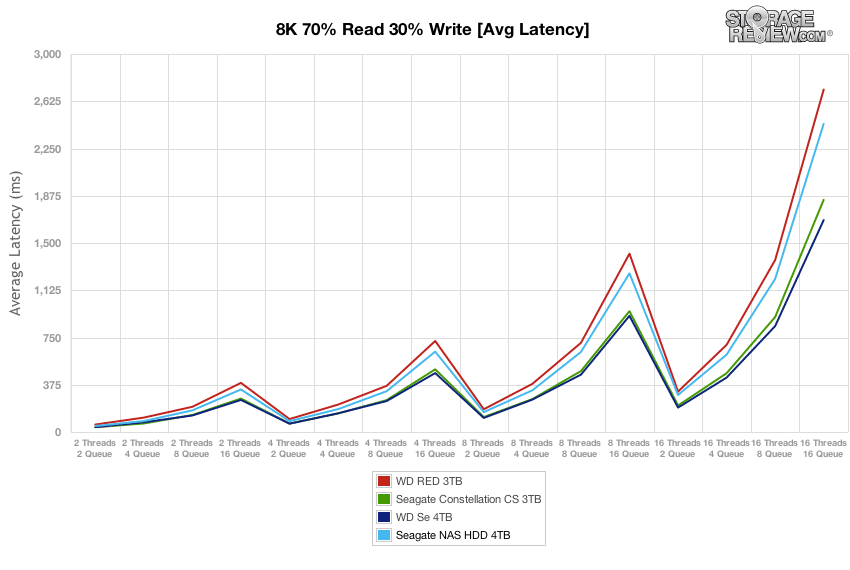
Over the duration of our primary tests at varying thread and queue depth levels, the Seagate NAS HDD had max latency that placed second from the bottom at 585.98ms for the 2 threads and 2 queue depth level and 6,100ms at the 16 thread and 16 queue depth level.
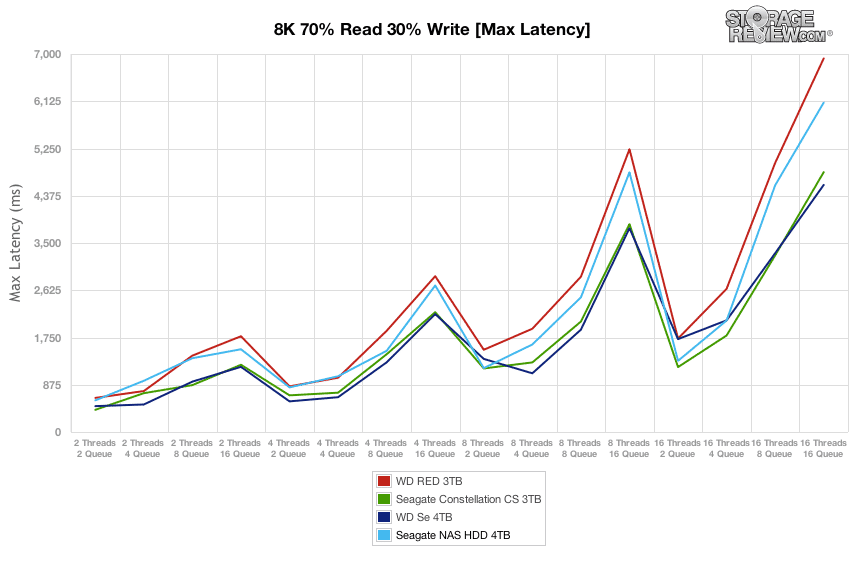
For the majority of the thread/queue spectrum, the Seagate NAS HDD maintained latency decently lower than the WD Red, though higher than the other two competing HDDs.
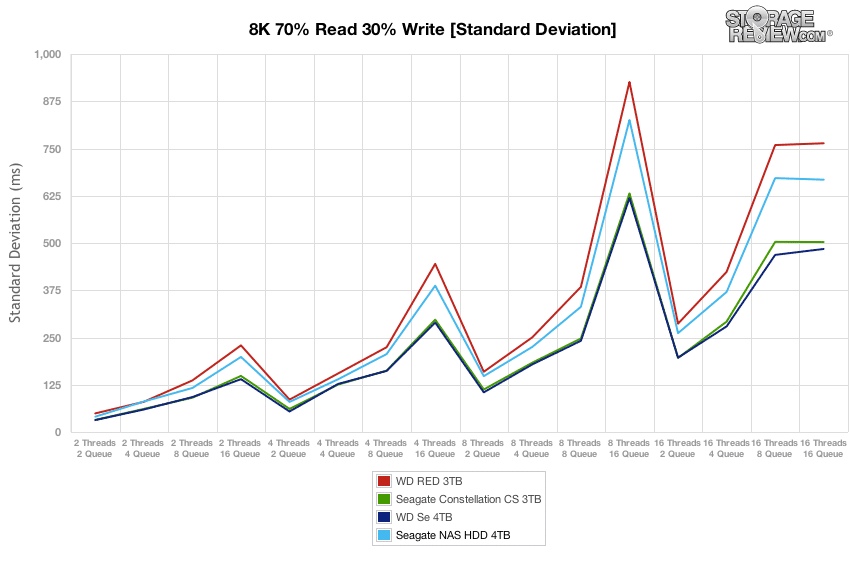
Fairly recently, we added a 128k test to our Enterprise Synthetic Workload which is a large block sequential test that shows the highest sequential transfer speed for a platter drive. Looking at the 128k performance of 100% write and 100% read activity, the Seagate NAS HDD performed with greater throughput than the WD Red again, though it was out-performed by the Seagate Constellation CS and WD Se. The Seagate NAS HDD posted 164,238KB/s read and 163,071KB/s write.
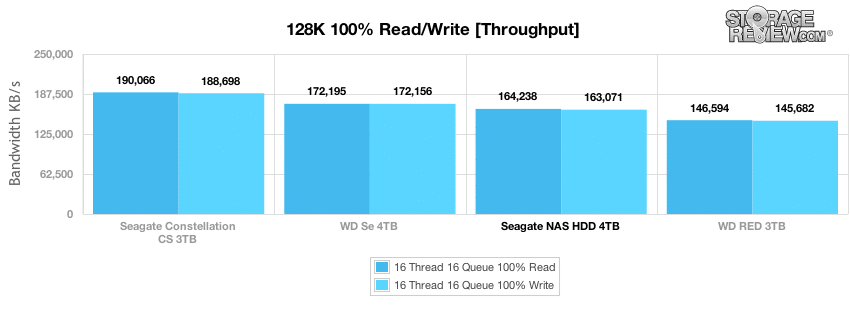
The next workload we used is our File Server profile which puts the drives through a varying workload. We scaled the thread and queue count from 2T/2Q up to 16T/16Q. Under this range of workloads, the Seagate NAS HDD ranked second from the bottom of the group at a max of 82 IOPS, just slightly above the WD Red.
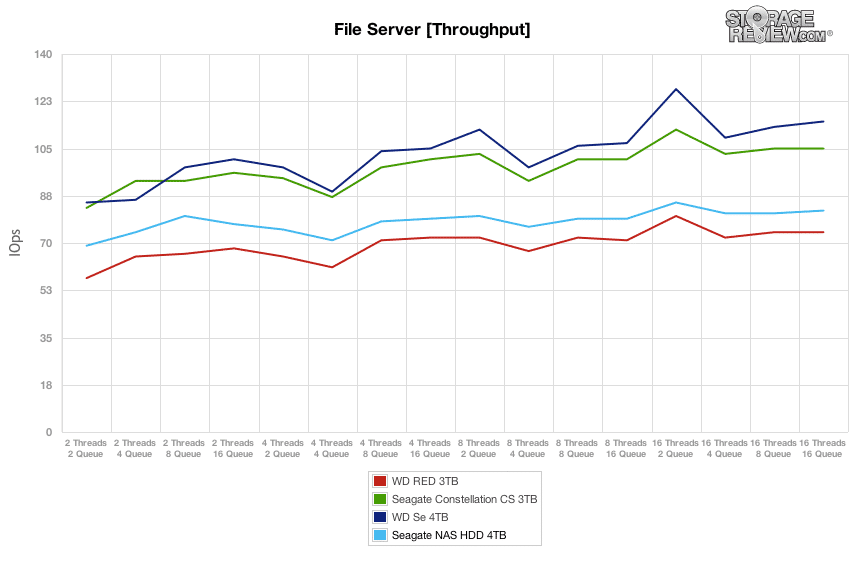
At all queue depths, the Seagate NAS HDD was second from the bottom of the group, beating out the WD Red again at 3,074ms.
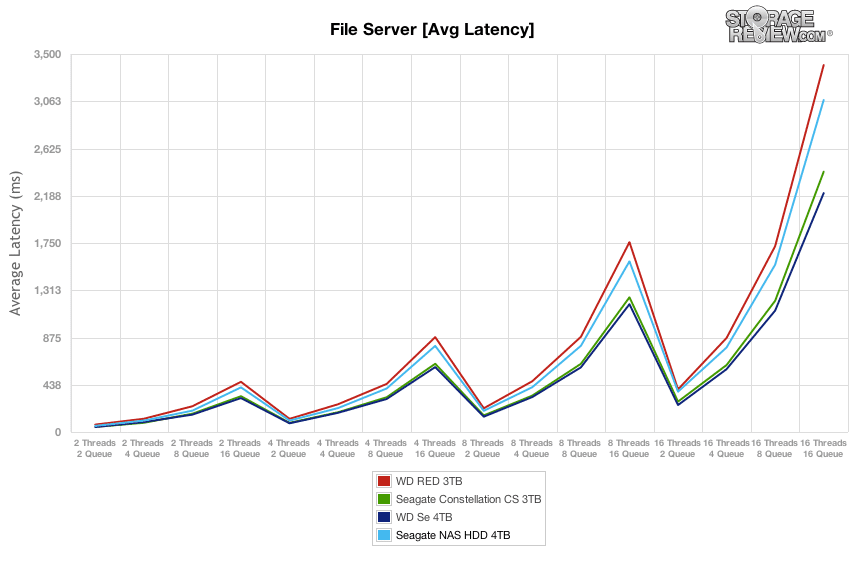
Comparing peak response times in our File Server profile, the Seagate NAS HDD maintained its 3rd place position throughout the queue depths, continually edging out the WD Red and finishing at 7,502ms.
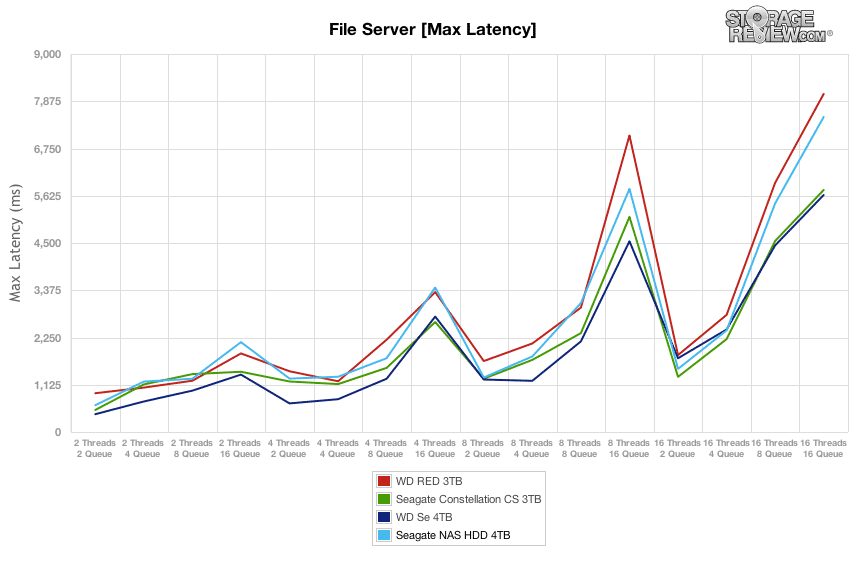
Looking at the latency standard deviation, the Seagate NAS HDD was able to best just the WD Red again.
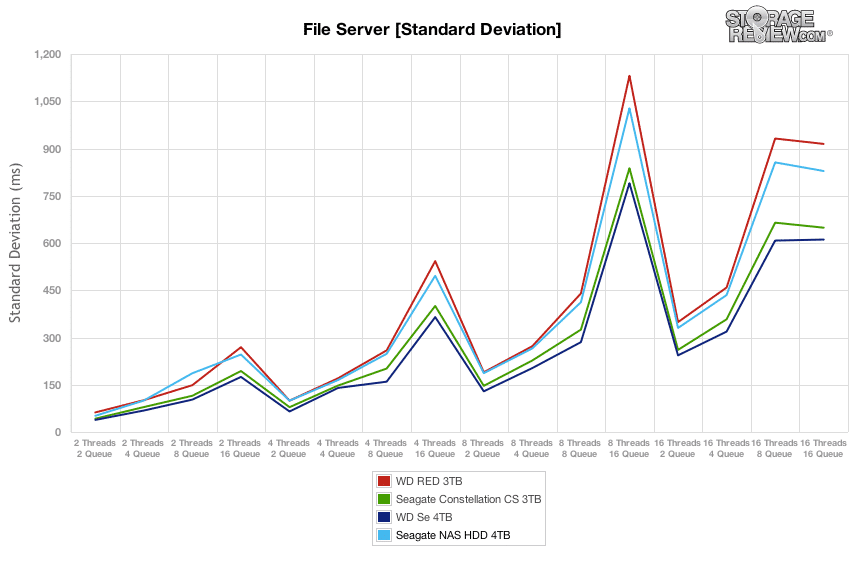
Our final test is the Web Server test, which is traditional 100% read activity. The Seagate NAS HDD peaked at 102 IOPS at 16T2Q with a terminal queue depth reading at 89 IOPS. That ranked above the WD Red.
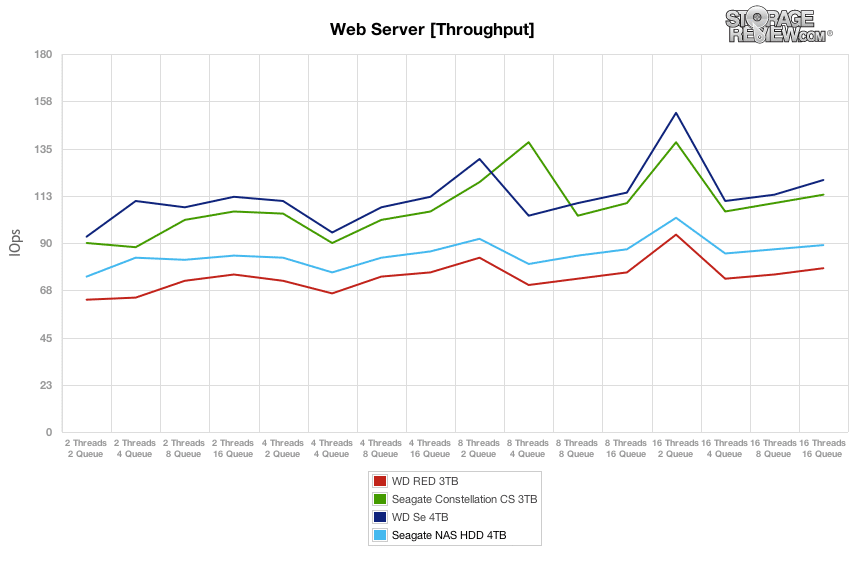
With a terminal queue depth reading of 2857.4ms, the Seagate NAS HDD performed just above the WD Red in our next test of average latency in the Web Server profile, though it was edged out by the other two drives.
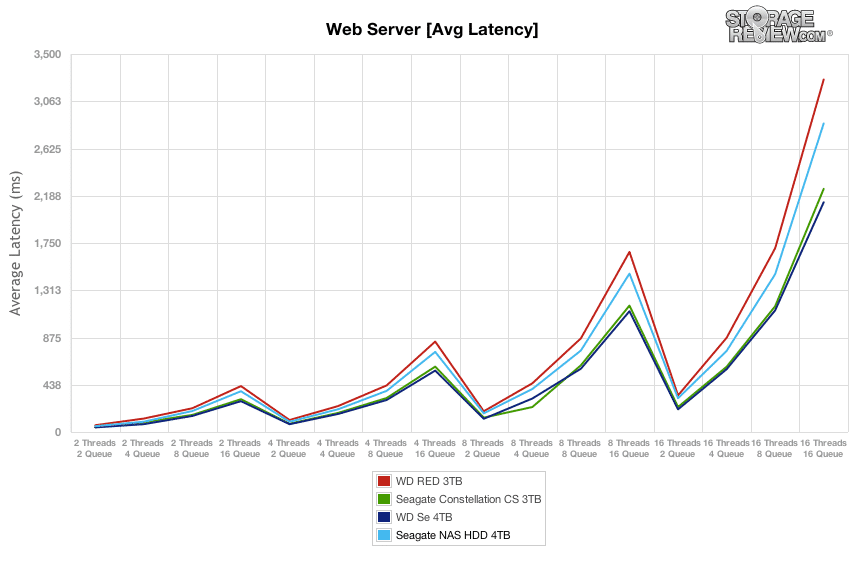
Looking at Max Latency in our Web Server profile, the Seagate NAS HDD took third place again with a max response in the terminal queue depth at 6238ms.
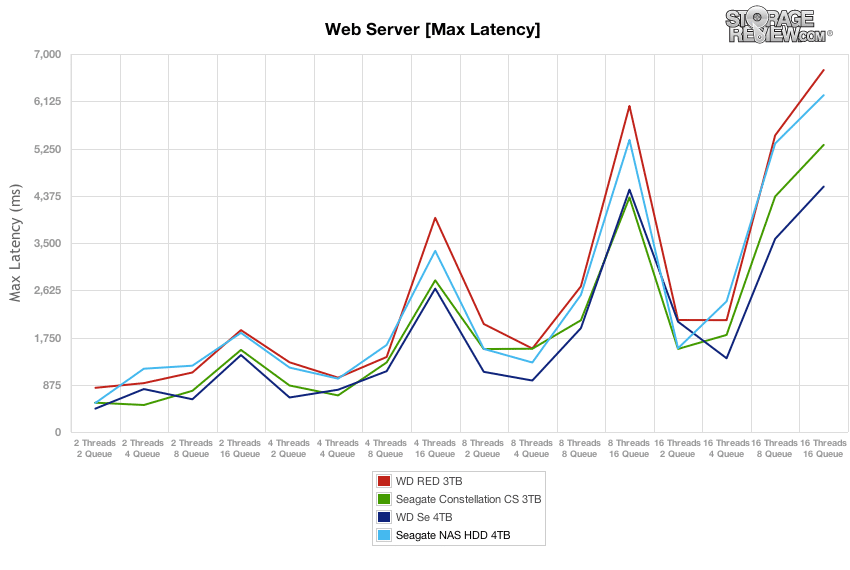
Comparing latency consistency in our read-only Web Server profile, the Seagate NAS HDD again found itself just ahead of the WD Red for the bulk of the test.
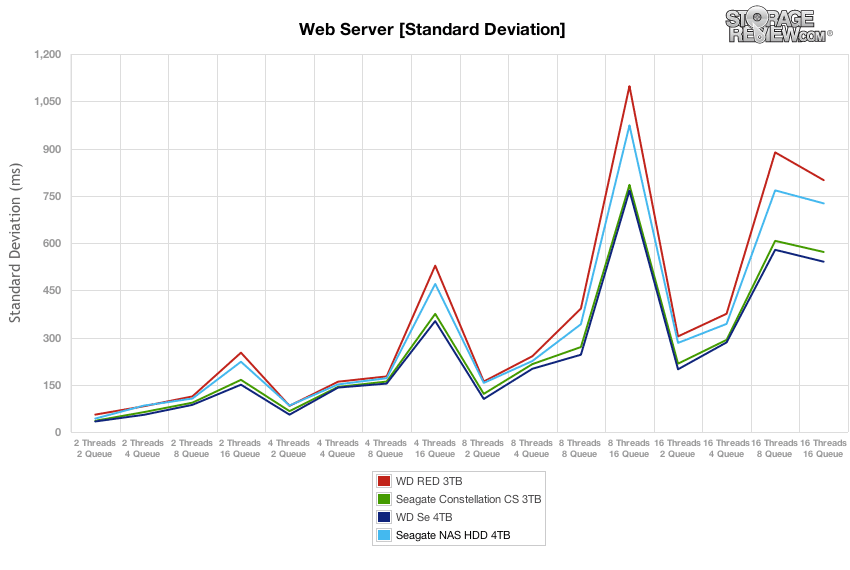
Conclusion
The Seagate NAS HDD is one of just two drives on the market designed specifically for implementation in small NAS devices. The NAS HDD comes in capacities up to 4TB with spindle speeds at 5,900RPM and a 6Gb/s SATA interface. Seagate engineered the NAS HDD in response to the different performance and reliability requirements NAS devices have compared to standard desktop HDDs. Seagate delivers an option for users to populate a NAS device from a range of the many supported devices Seagate tested against with the NAS HDD. Providing greater assurance that the NAS HDD will provide performance and reliability, Seagate developed and included NASWorks firmware. The firmware fine-tunes the drive using a range of features. It includes error recovery controls, ensuring that the drive complies with NAS system requirements, and it also features power profiles for low power options that are significant to users running several drives.
When we ran the Seagate NAS HDD through the paces, we expected performance to be solid, but it's also significant to keep in mind that the drive is primarily designed around enhancing itself for NAS workloads and environments. That's why Seagate engineered and implemented the NASWorks firmware; this isn't just an HDD, it's a drive designed for longevity in continuous operation, 24/7 NAS scenarios.
For comparables, we tested the Seagate NAS HDD against the WD Red, the only other small NAS-specific drive on the market as well as the entry-enterprise WD Se and Seagate Constellation CS which are designed larger NAS deployments. The Seagate NAS HDD 4TB outperformed the WD Red 3TB (top capacity for that model) in just about every test. As expected, the NAS HDD wasn't able to exceed the transfer speeds nor maintain lower response times than the WD Se and Seagate Constellation CS, but of course those are enterprise class drives. The NAS HDD did excel where it mattered, posting better throughput than the WD Red, and it provided tighter latency consistency in all of our mixed workloads. At the same time though, the NAS HDD's 4k max latency write figure was at the back of the group. Overall, the NAS HDD provides better performance than the market's other option, the WD Red, while providing the features necessary for NAS implementation.
Pros
- Higher mixed workload and sequential throughput than WD Red
- Greatest capacity in NAS HDD segment
- Better latency consistency in mixed workloads than WD Red
Cons
- Back of the group random 4k max latency in write activity
Bottom Line
The Seagate NAS HDD comes in capacities up to 4TB and includes specially designed firmware that is engineered to deliver greater reliability and performance to provide consumers with assurance when they select drives with which to populate their new NAS. With class-leading performance, the Seagate NAS HDD family is a great option for small NAS owners.
